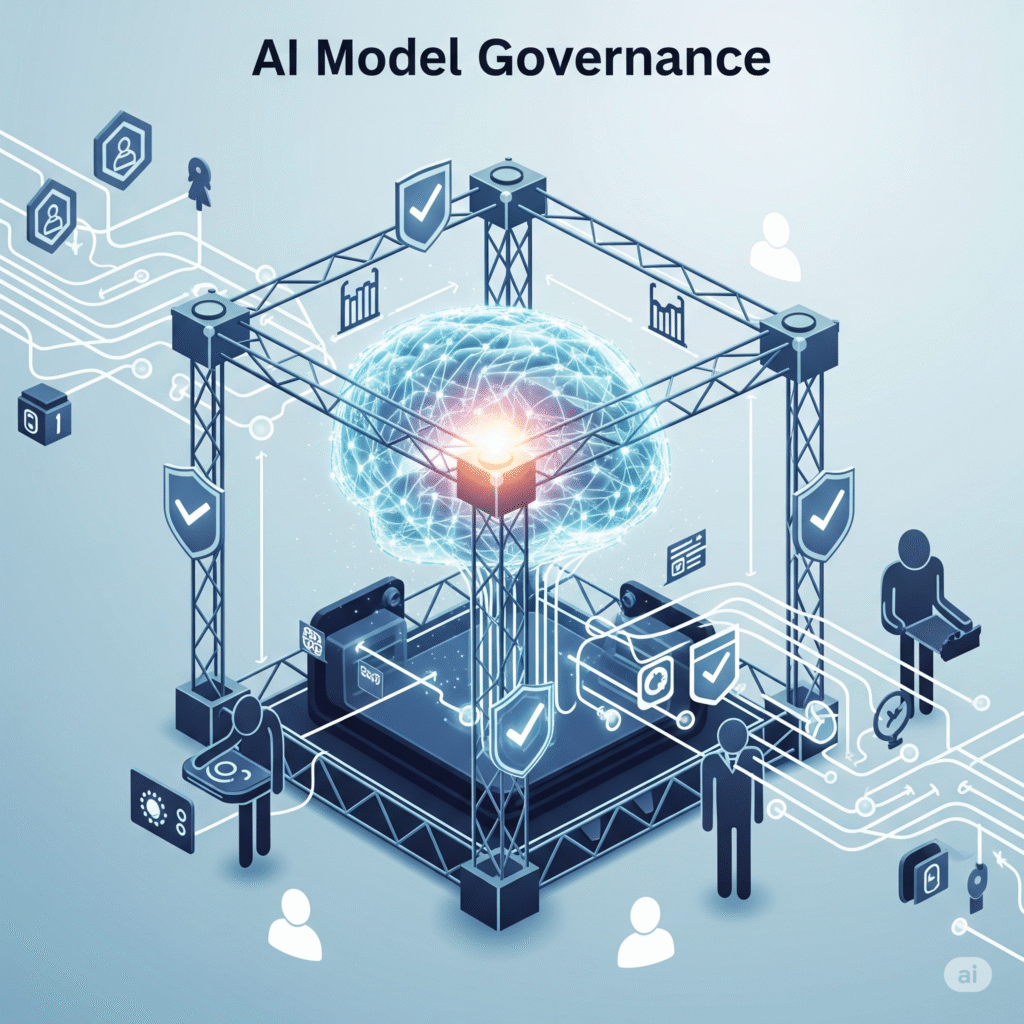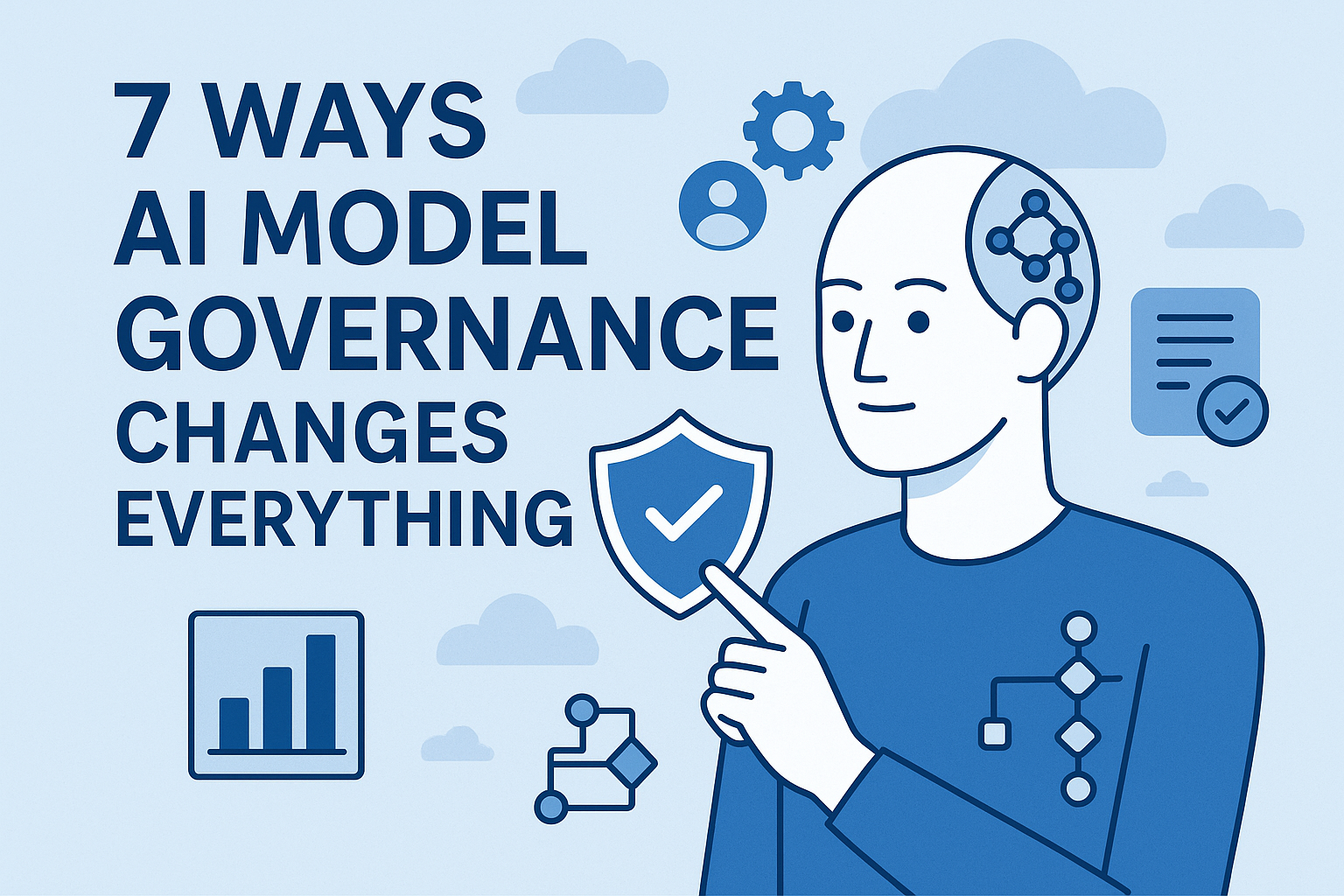What if your cutting-edge AI, the one promising revolutionary breakthroughs, silently introduced bias, violated privacy, or suddenly made inexplicable decisions?
AI model governance isn’t just a buzzword; it’s the strategic framework that ensures your Artificial Intelligence operates ethically, compliantly, and reliably. In an era where AI is rapidly becoming the backbone of modern business—from powering personalized customer experiences to automating critical operations—the stakes have never been higher. Without proper oversight, your AI can transform from a powerful asset into a significant liability, exposing your organization to legal challenges, reputational damage, and a loss of stakeholder trust.
This expert guide will demystify AI model governance, providing you with the essential knowledge and actionable strategies to build trustworthy, compliant, and innovative AI systems. You’ll learn how to navigate the evolving landscape of AI ethics and regulation, transforming your AI from a potential black box into a transparent, accountable, and ultimately, a more powerful strategic advantage.
Understanding the Core: What is AI Model Governance?
AI model governance is a specialized subset of AI governance, focusing specifically on how organizations should develop, deploy, and use AI and machine learning models safely, ethically, and responsibly. It encompasses the policies, procedures, and frameworks that ensure AI systems operate within legal, ethical, and organizational boundaries.
Think of it as the guardrails for your AI, ensuring that your intelligent systems are not only effective but also fair, transparent, and accountable. It’s about proactive management throughout the entire AI lifecycle, from data collection and model training to deployment and continuous monitoring.
Why AI Model Governance Isn’t Optional Anymore

The rise of AI has brought unprecedented opportunities, but also significant challenges. Ignoring AI model governance can lead to severe consequences.
Mitigating Risks: From Bias to Breaches
- Algorithmic Bias: AI models learn from data. If that data contains historical biases, the AI will perpetuate and even amplify them. This can lead to discriminatory outcomes in areas like hiring, lending, or even healthcare.
- Data Privacy Concerns: AI models often consume vast amounts of data, including sensitive personal information. Without proper governance, there’s a heightened risk of privacy breaches and misuse of data.
- Security Vulnerabilities: AI systems can be targets for cyberattacks, and poor governance can expose critical infrastructure or sensitive information.
Ensuring Regulatory Compliance
Governments worldwide are rapidly enacting new AI regulations. Compliance is no longer a “nice-to-have” but a legal imperative.
- The EU AI Act: This landmark regulation categorizes AI systems by risk, imposing stringent requirements on high-risk AI applications. Non-compliance can result in hefty fines (up to 7% of global annual turnover or €35 million, whichever is higher).
- GDPR (General Data Protection Regulation): AI systems handling personal data in the EU must adhere to GDPR principles, including data minimization, consent, and the right to explanation.
- NIST AI Risk Management Framework (USA): Provides voluntary guidelines for managing AI risks, gaining traction as an industry standard.
Building and Maintaining Trust
In an era of increasing skepticism about AI, trust is your most valuable currency.
- Stakeholder Confidence: Effective AI model governance fosters confidence among customers, employees, investors, and regulators. When people trust your AI, they are more likely to adopt and rely on your products and services.
- Reputation Management: A single AI incident involving bias or privacy can severely damage your brand’s reputation, leading to loss of customers and market value.
- Ethical Innovation: Governance encourages responsible innovation, ensuring that AI is developed and deployed in a way that benefits society and aligns with ethical principles.
Key Pillars of Effective AI Model Governance
A robust AI model governance framework stands on several foundational pillars:
1. Ethical Principles & Guidelines
This is the bedrock. Define your organization’s core values and translate them into specific ethical principles for AI development and deployment.
- Fairness and Non-discrimination: Ensure AI systems treat all individuals and groups equitably, actively mitigating bias.
- Transparency and Explainability: Strive to make AI decision-making processes understandable, even to non-technical stakeholders. This includes documenting model logic and data sources.
- Accountability: Clearly define who is responsible for AI outcomes, both within development teams and across the organization.
- Privacy and Security: Implement stringent data protection measures and secure AI systems against threats.
2. Risk Management & Bias Mitigation
Proactively identify, assess, and mitigate risks throughout the AI lifecycle.
- Risk Assessments: Conduct thorough assessments for each AI model, evaluating potential for bias, security vulnerabilities, and regulatory compliance gaps.
- Bias Detection & Remediation: Implement tools and processes to identify and correct biases in training data and model outputs. This might involve techniques like data re-balancing or re-weighting.
- Adversarial Robustness: Design models that are resilient to malicious attacks intended to manipulate their behavior.
3. Data Governance Integration
AI models are only as good as the data they consume. AI model governance must be tightly integrated with your overall data governance strategy.
- Data Quality & Provenance: Ensure the data used to train and operate AI models is accurate, complete, and reliable. Understand its origin and transformations.
- Data Privacy & Consent: Adhere to all relevant data privacy regulations (e.g., GDPR, CCPA). Establish clear consent mechanisms for data collection and usage.
- Data Lineage: Track the journey of data from its source through various transformations to its use in AI models. This provides an audit trail for transparency and debugging.
4. Lifecycle Management & Monitoring
Governance isn’t a one-time setup; it’s a continuous process.
- Model Validation & Testing: Rigorously test AI models for performance, fairness, and robustness before deployment.
- Continuous Monitoring: Implement real-time monitoring of deployed AI models to detect drift, performance degradation, and emerging biases.
- Audit Trails & Documentation: Maintain comprehensive documentation of model development, training data, performance metrics, and any interventions. This is crucial for compliance and accountability.
- Version Control: Manage different versions of your AI models and associated data to ensure reproducibility and traceability.
5. Human Oversight & Intervention
AI should augment, not entirely replace, human judgment.
- Human-in-the-Loop (HITL): Design processes where humans can review and intervene in AI decisions, especially for high-stakes applications.
- Clear Intervention Protocols: Define when and how human intervention should occur, and establish clear escalation paths.
- Training and Education: Ensure all stakeholders, from developers to business leaders, understand AI governance policies and their roles in responsible AI.
Best Practices for Implementing AI Model Governance

Putting governance into practice requires a strategic approach.
- Start Early: Integrate governance considerations from the very beginning of the AI development lifecycle, not as an afterthought.
- Cross-Functional Collaboration: Form an AI model governance team with representatives from legal, compliance, ethics, data science, engineering, and business units. This ensures a holistic perspective.
- Define Clear Roles & Responsibilities: Who owns the data? Who is responsible for monitoring model performance? Who approves model deployments? Clarity avoids confusion and accountability gaps.
- Adopt a Risk-Based Approach: Prioritize governance efforts based on the potential impact and risk level of each AI model. A credit scoring model requires more stringent governance than a content recommendation engine.
- Leverage Technology: Utilize specialized AI model governance tools and platforms that can automate monitoring, bias detection, and documentation. For example, tools like IBM Watsonx.governance, Credo AI, or Holistic AI offer features for managing the AI lifecycle, tracking compliance, and ensuring transparency.
- Regular Audits & Reviews: Conduct periodic internal and external audits to assess compliance, identify new risks, and refine your governance framework.
- Stay Agile & Adaptive: The AI landscape is constantly evolving. Your governance framework must be flexible enough to adapt to new technologies, regulations, and ethical considerations.
Challenges in AI Model Governance
While essential, implementing robust AI model governance is not without its hurdles.
- Complexity of AI Systems: Many advanced AI models, especially deep learning networks, are “black boxes,” making their internal decision-making processes difficult to understand and explain.
- Evolving Regulations: The regulatory landscape for AI is still nascent and rapidly changing, making it challenging to keep governance frameworks up-to-date.
- Data Volume & Velocity: The sheer volume and speed of data used by AI models make continuous monitoring and quality control a significant task.
- Lack of Skilled Personnel: There’s a shortage of professionals with expertise in both AI technology and governance principles.
- Balancing Innovation & Control: Striking the right balance between fostering rapid AI innovation and implementing necessary controls can be tricky. Overly stringent regulations can stifle creativity.
What’s the biggest challenge your organization faces when thinking about AI model governance? Share your thoughts in the comments below!
The Future of AI Model Governance: A Proactive & Integrated Approach

The future of AI model governance will see deeper integration, increased automation, and a stronger emphasis on ethical design.
- AI-Driven Governance: We’ll see AI systems themselves being used to monitor, audit, and even govern other AI systems, leading to more efficient and scalable governance processes.
- Convergence with Data Governance: AI governance will become seamlessly integrated with broader data governance strategies, recognizing that data is the lifeblood of AI.
- Standardization & Interoperability: Efforts to create global standards and interoperable governance frameworks will intensify, simplifying compliance for multinational organizations.
- Focus on Explainable AI (XAI): Research and development in XAI will continue to advance, making AI decisions more transparent and interpretable.
- Citizen AI & Ethical AI by Design: There will be a greater emphasis on embedding ethical considerations and governance principles into the very design of AI systems, rather than tacking them on later.
Conclusion: Your Pathway to Responsible AI
AI model governance is no longer a niche concern; it’s a strategic imperative for any organization leveraging artificial intelligence. By embracing a proactive, principled, and technologically-informed approach to governance, you can:
- Unlock the full potential of your AI investments
- Build unwavering trust with your stakeholders
- Navigate the complex regulatory landscape with confidence
- Foster responsible innovation that benefits both your business and society
Don’t let your AI become a liability. Start building your robust AI model governance framework today.
Ready to ensure your AI models are trustworthy and compliant?
- Share this guide with your team and leadership to spark a conversation about AI governance!
- What aspects of AI model governance are you most interested in exploring further? Leave a comment below!
Implementing robust AI model governance is no longer optional but a critical imperative for organizations navigating the complex landscape of artificial intelligence, a sentiment echoed by recent analyses from leading industry research firms, as highlighted in a Gartner report on responsible AI trends
This proactive approach helps mitigate significant risks, from algorithmic bias and data privacy breaches to ensuring compliance with burgeoning global regulations like the EU AI Act, which, according to the European Commission’s official documentation imposes stringent requirements on high-risk AI systems.
Understanding the various frameworks and models available is key to successful implementation, and for a deeper dive into specific structures and their applications, you can explore detailed insights on AI governance models which further elaborates on how enterprises can systematically manage their AI initiatives, mirroring best practices outlined by organizations such as NIST in their AI Risk Management Framework.

